ECU VAUXHALL ADAM 2016.5 User Guide
[x] Cancel search | Manufacturer: VAUXHALL, Model Year: 2016.5, Model line: ADAM, Model: VAUXHALL ADAM 2016.5Pages: 239, PDF Size: 7.2 MB
Page 50 of 239

48Seats, restraints1:if the child restraint system is being secured using a three-point seat belt, adjust seat backrest inclination to a vertical
position to ensure that the belt is tight on the buckle side. Move seat height adjustment in the uppermost position.2:remove rear head restraint when using child restraint systems in this group 3 32*:move the respective front seat ahead of the child restraint system to one of the foremost adjustment positions**:move the front passenger seat to the rearmost adjustment position. Move seat height adjustment to the uppermost
position and the headrest to the lowest position. Adjust seat backrest inclination as far as necessary to a verticalposition to ensure that vehicle seat belt runs forwards from the upper anchorage pointU:universal suitability in conjunction with three-point seat beltX:no child restraint system permitted in this weight class
Permissible options for fitting an ISOFIX child restraint system
Weight classSize classFixtureOn front passenger seatOn rear seatsGroup 0: up to 10 kg
or approx. 10 monthsEISO/R1XIL *Group 0+: up to 13 kg
or approx. 2 yearsEISO/R1XIL *DISO/R2XXCISO/R3XXGroup I: 9 to 18 kg
or approx. 8 months to 4 yearsDISO/R2XXCISO/R3XXBISO/F2XIL, IUF**B1ISO/F2XXIL, IUF**AISO/F3XIL, IUF**
Page 55 of 239
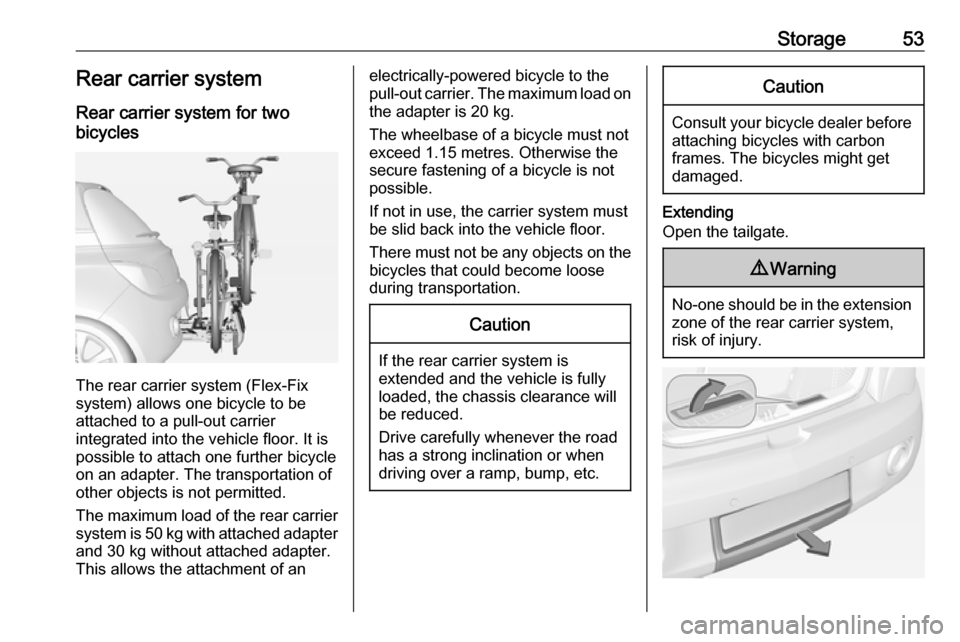
Storage53Rear carrier system
Rear carrier system for two
bicycles
The rear carrier system (Flex-Fix
system) allows one bicycle to be attached to a pull-out carrier
integrated into the vehicle floor. It is possible to attach one further bicycleon an adapter. The transportation of
other objects is not permitted.
The maximum load of the rear carrier
system is 50 kg with attached adapter
and 30 kg without attached adapter.
This allows the attachment of an
electrically-powered bicycle to the
pull-out carrier. The maximum load on the adapter is 20 kg.
The wheelbase of a bicycle must not
exceed 1.15 metres. Otherwise the
secure fastening of a bicycle is not
possible.
If not in use, the carrier system must
be slid back into the vehicle floor.
There must not be any objects on the bicycles that could become loose
during transportation.Caution
If the rear carrier system is
extended and the vehicle is fully
loaded, the chassis clearance will
be reduced.
Drive carefully whenever the road has a strong inclination or when
driving over a ramp, bump, etc.
Caution
Consult your bicycle dealer before
attaching bicycles with carbon
frames. The bicycles might get
damaged.
Extending
Open the tailgate.
9 Warning
No-one should be in the extension
zone of the rear carrier system,
risk of injury.
Page 58 of 239
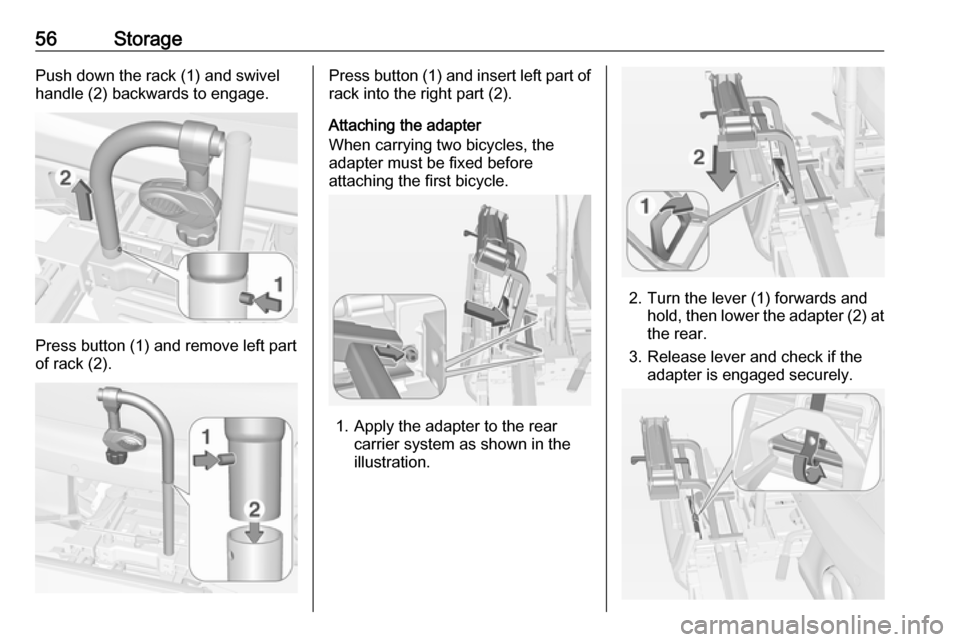
56StoragePush down the rack (1) and swivel
handle (2) backwards to engage.
Press button (1) and remove left part
of rack (2).
Press button (1) and insert left part of
rack into the right part (2).
Attaching the adapter
When carrying two bicycles, the
adapter must be fixed before
attaching the first bicycle.
1. Apply the adapter to the rear carrier system as shown in the
illustration.
2. Turn the lever (1) forwards and hold, then lower the adapter (2) at
the rear.
3. Release lever and check if the adapter is engaged securely.
Page 59 of 239
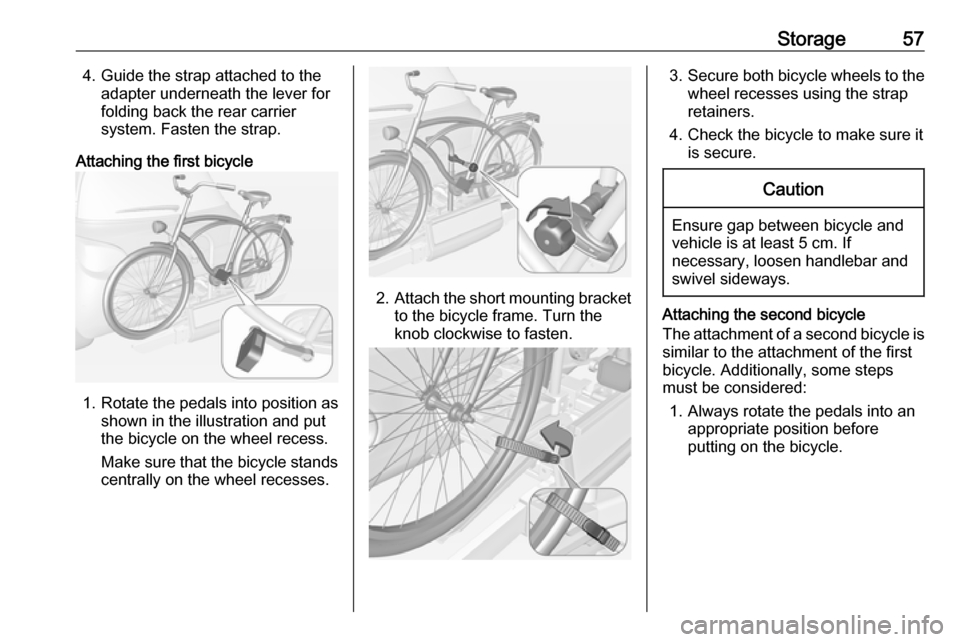
Storage574. Guide the strap attached to theadapter underneath the lever for
folding back the rear carrier
system. Fasten the strap.
Attaching the first bicycle
1. Rotate the pedals into position as shown in the illustration and put
the bicycle on the wheel recess.
Make sure that the bicycle stands centrally on the wheel recesses.
2. Attach the short mounting bracket
to the bicycle frame. Turn the
knob clockwise to fasten.
3. Secure both bicycle wheels to the
wheel recesses using the strap
retainers.
4. Check the bicycle to make sure it is secure.Caution
Ensure gap between bicycle and
vehicle is at least 5 cm. If
necessary, loosen handlebar and swivel sideways.
Attaching the second bicycle
The attachment of a second bicycle is
similar to the attachment of the first
bicycle. Additionally, some steps
must be considered:
1. Always rotate the pedals into an appropriate position before
putting on the bicycle.
Page 60 of 239
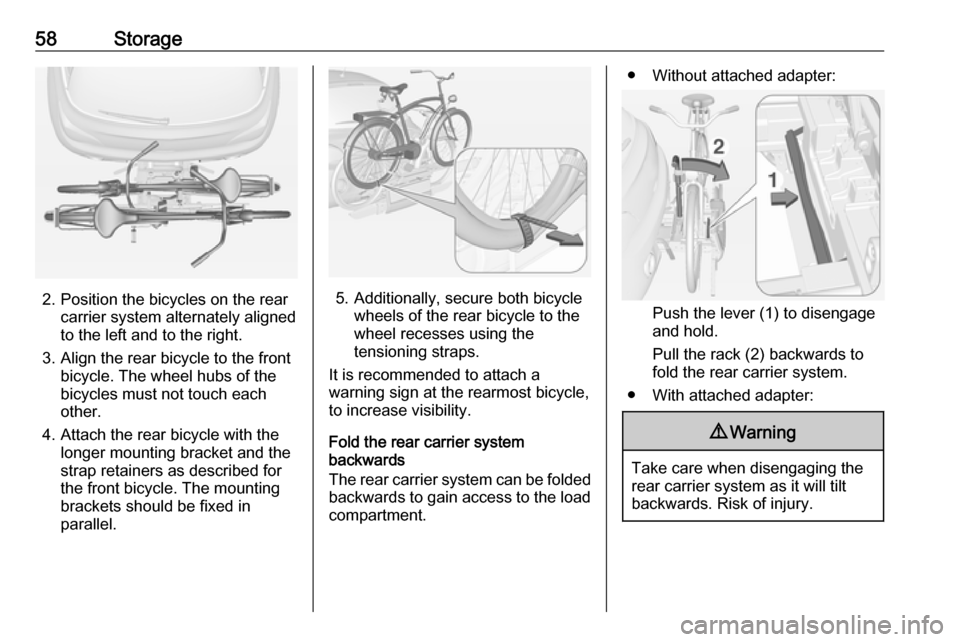
58Storage
2. Position the bicycles on the rearcarrier system alternately aligned
to the left and to the right.
3. Align the rear bicycle to the front bicycle. The wheel hubs of the
bicycles must not touch each
other.
4. Attach the rear bicycle with the longer mounting bracket and the
strap retainers as described for
the front bicycle. The mounting
brackets should be fixed in
parallel.5. Additionally, secure both bicycle wheels of the rear bicycle to the
wheel recesses using the
tensioning straps.
It is recommended to attach a
warning sign at the rearmost bicycle,
to increase visibility.
Fold the rear carrier system
backwards
The rear carrier system can be folded
backwards to gain access to the load compartment.
● Without attached adapter:
Push the lever (1) to disengage
and hold.
Pull the rack (2) backwards to
fold the rear carrier system.
● With attached adapter:
9 Warning
Take care when disengaging the
rear carrier system as it will tilt
backwards. Risk of injury.
Page 61 of 239
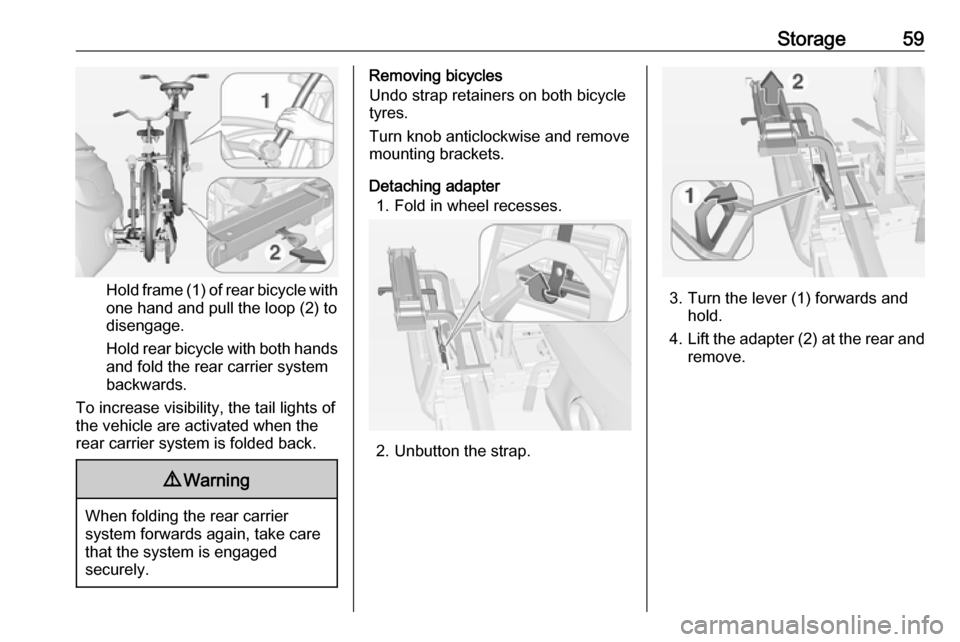
Storage59
Hold frame (1) of rear bicycle with
one hand and pull the loop (2) to
disengage.
Hold rear bicycle with both hands and fold the rear carrier system
backwards.
To increase visibility, the tail lights of
the vehicle are activated when the
rear carrier system is folded back.
9 Warning
When folding the rear carrier
system forwards again, take care
that the system is engaged
securely.
Removing bicycles
Undo strap retainers on both bicycle
tyres.
Turn knob anticlockwise and remove
mounting brackets.
Detaching adapter 1. Fold in wheel recesses.
2. Unbutton the strap.
3. Turn the lever (1) forwards and hold.
4. Lift the adapter (2) at the rear and
remove.
Page 64 of 239
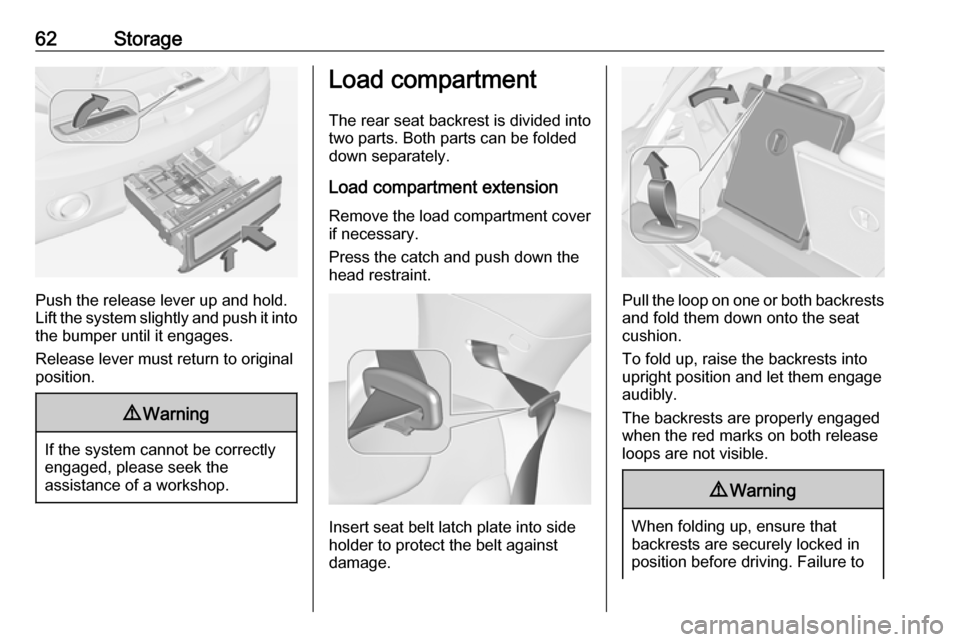
62Storage
Push the release lever up and hold.
Lift the system slightly and push it into the bumper until it engages.
Release lever must return to original
position.
9 Warning
If the system cannot be correctly
engaged, please seek the
assistance of a workshop.
Load compartment
The rear seat backrest is divided into
two parts. Both parts can be folded
down separately.
Load compartment extension
Remove the load compartment cover
if necessary.
Press the catch and push down the
head restraint.
Insert seat belt latch plate into side
holder to protect the belt against
damage.
Pull the loop on one or both backrests and fold them down onto the seat
cushion.
To fold up, raise the backrests into
upright position and let them engage
audibly.
The backrests are properly engaged
when the red marks on both release
loops are not visible.
9 Warning
When folding up, ensure that
backrests are securely locked in
position before driving. Failure to
Page 68 of 239
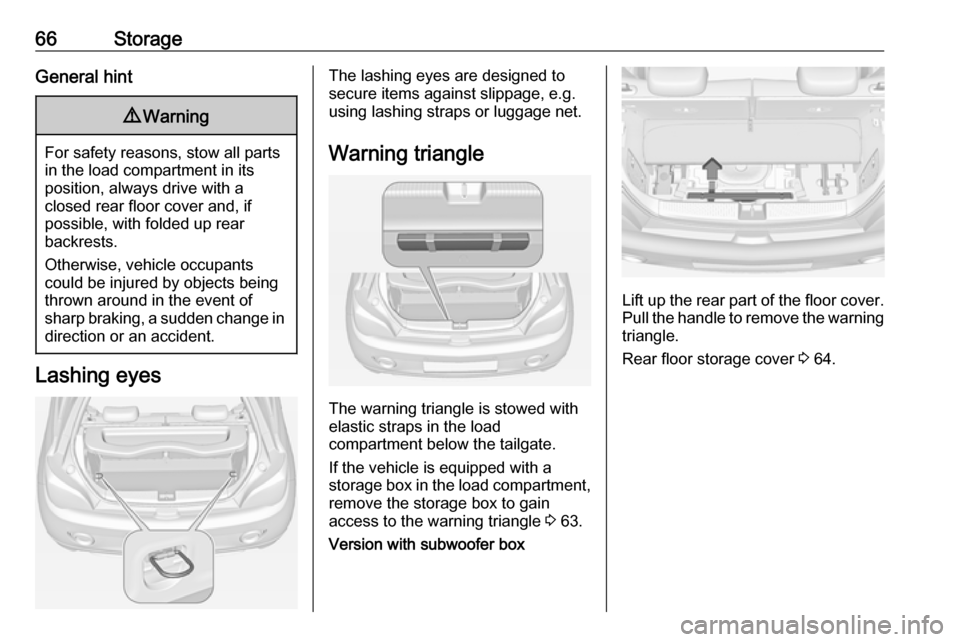
66StorageGeneral hint9Warning
For safety reasons, stow all parts
in the load compartment in its
position, always drive with a
closed rear floor cover and, if
possible, with folded up rear
backrests.
Otherwise, vehicle occupants
could be injured by objects being
thrown around in the event of
sharp braking, a sudden change in direction or an accident.
Lashing eyes
The lashing eyes are designed to
secure items against slippage, e.g.
using lashing straps or luggage net.
Warning triangle
The warning triangle is stowed with
elastic straps in the load
compartment below the tailgate.
If the vehicle is equipped with a
storage box in the load compartment,
remove the storage box to gain
access to the warning triangle 3 63.
Version with subwoofer box
Lift up the rear part of the floor cover. Pull the handle to remove the warning
triangle.
Rear floor storage cover 3 64.
Page 69 of 239
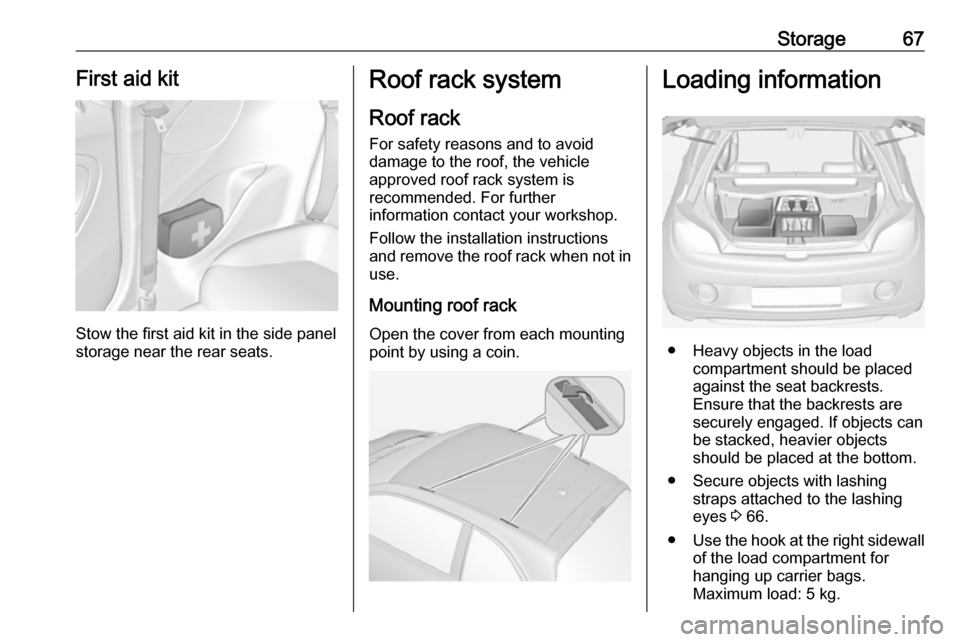
Storage67First aid kit
Stow the first aid kit in the side panel
storage near the rear seats.
Roof rack system
Roof rack
For safety reasons and to avoid
damage to the roof, the vehicle
approved roof rack system is
recommended. For further
information contact your workshop.
Follow the installation instructions
and remove the roof rack when not in use.
Mounting roof rack Open the cover from each mounting
point by using a coin.Loading information
● Heavy objects in the load compartment should be placed
against the seat backrests.
Ensure that the backrests are
securely engaged. If objects can
be stacked, heavier objects
should be placed at the bottom.
● Secure objects with lashing straps attached to the lashing
eyes 3 66.
● Use the hook at the right sidewall
of the load compartment for
hanging up carrier bags.
Maximum load: 5 kg.
Page 70 of 239

68Storage● Secure loose objects in the loadcompartment to prevent themfrom sliding.
● When transporting objects in the load compartment, the backrests
of the rear seats must not be
angled forward.
● Do not allow the load to protrude above the upper edge of the
backrests.
● Do not place any objects on the load compartment cover or the
instrument panel, and do not cover the sensor on top of the
instrument panel.
● The load must not obstruct the operation of the pedals, parking
brake and gear selector lever, or
hinder the freedom of movement of the driver. Do not place any
unsecured objects in the interior.
● Do not drive with an open load compartment.9Warning
Always make sure that the load in
the vehicle is securely stowed.
Otherwise objects can be thrown
around inside the vehicle and
cause personal injury or damage
to the load or vehicle.
● The payload is the difference between the permitted gross
vehicle weight (see identification
plate 3 213) and the EC kerb
weight.
To calculate the payload, enter
the data for your vehicle in the
weights table at the front of this
manual.
The EC kerb weight includes
weights for the driver (68 kg),
luggage (7 kg) and all fluids (fuel
tank 90% full).
Optional equipment and
accessories increase the kerb
weight.
● Driving with a roof load increases
the sensitivity of the vehicle to
cross-winds and has a
detrimental effect on vehicle
handling due to the vehicle's
higher centre of gravity.
Distribute the load evenly and secure it properly with retaining
straps. Adjust the tyre pressure
and vehicle speed according to
the load conditions. Check and
retighten the straps frequently.
Do not drive faster than 75 mph.
The permissible roof load is
50 kg. The roof load is the
combined weight of the roof rack and the load.